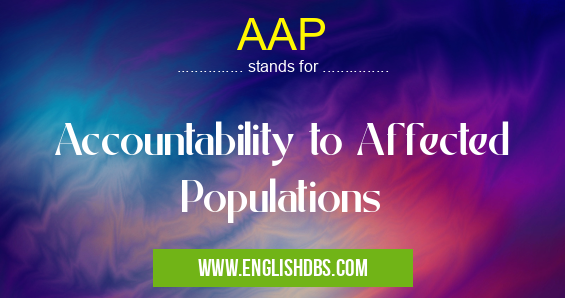What does AAP mean in UNITED NATIONS
Accountability to affected populations (AAP) is an approach which requires an organization or institution to be accountable to those groups whose lives are likely to be affected by the decisions it makes or the actions it takes. Accountability can take many different forms, including providing public information on decision making processes, consulting with stakeholders, and responding to grievances. As such, AAP is a holistic approach that seeks to ensure that marginalized and vulnerable groups are not only consulted and involved in decision-making processes but also are empowered and fully informed of the outcomes of decisions that affect their lives.

AAP meaning in United Nations in Governmental
AAP mostly used in an acronym United Nations in Category Governmental that means Accountability to Affected Populations
Shorthand: AAP,
Full Form: Accountability to Affected Populations
For more information of "Accountability to Affected Populations", see the section below.
Definition
AAP is a framework for organizations or institutions to be held responsible for their decisions and actions. It involves creating meaningful opportunities for impacted populations, such as those from underserved communities, minority groups, or people living in rural areas, to participate in decision-making processes at all stages of implementation. Furthermore, it requires organizations and institutions provide clear information on how decisions were made along with access to appeals mechanisms for those who feel that their rights have been violated. Consequently, AAP encourages accountability through transparency and empowerment thus building trust between individuals, private companies, governmental organizations and civil society actors.
Importance
The importance of AAP lies in its ability to bridge gaps between decision makers and affected populations. By involving impacted communities in decision making processes from the beginning until the end, AAP helps ensure that these individuals’ interests are taken into account and safeguards their rights against any form of abuse of power or disregard for consent prior consultation process has been followed. In addition, it serves as an effective way for organizations or institutions that have taken action which affects certain groups of people to accept responsibility if something goes wrong so they can address issues appropriately; thereby building stronger relationships based on mutual respect and understanding with their target populations.
Essential Questions and Answers on Accountability to Affected Populations in "GOVERNMENTAL»UN"
What is Accountability to Affected Populations (AAP)?
Accountability to Affected Populations (AAP) is a process that emphasizes creating and maintaining relationships of trust between affected populations and organizations during humanitarian responses. Its purpose is to enable the affected populations to hold the responding organization accountable for their programme activities in order to ensure more effective action.
How does AAP contribute to establishing trust between affected populations and organizations?
By providing greater transparency, understanding and communication between organizations and affected populations, AAP helps build trusting relationships which are beneficial for both parties. This trust enables organizations to respond effectively, by ensuring that their programmes are addressing the needs of those affected by crisis in an informed way.
Who is responsible for undertaking AAP measures?
It is the responsibility of both the organization providing assistance as well as the people suffering from a crisis or emergency situation to actively participate in AAP initiatives. The organization should use its expertise, resources, and funds available, while those affected must communicate their needs clearly so that proper interventions can be designed.
Does every organization need an Accountability Framework?
Organizations should have an accountability framework in place regardless of whether they are engaging with affected populations or not. It ensures that individuals involved in decision-making processes understand the value they bring as well as what their responsibilities are. This provides a clear road map for further accountability implementation since it sets out all outcomes and expectations before project begins.
What are some key elements of effective AAP measures?
Effective AAP measures should include mechanisms for listening to feedback from people affected by humanitarian crises; engaging with local stakeholders; being transparent about plans and progress; ensuring accessible communication; involving communities in decision-making; respecting local values customs and cultures; holding staff accountable for implementing tasks properly; being fair in dealing with grievances.
Why is it important to involve local stakeholders when implementing an accountability framework?
Involving local stakeholders such as community leaders or religious authorities ensures that any responses reflect cultural norms, values, customs and traditions, thus increasing its legitimacy within a given area. This also encourages collaboration between organizations giving aid and local communities who will become invested in successful implementation leading to better program outcomes.
How can appropriate feedback mechanisms be set up when communicating with people affected by a crisis?
Appropriate feedback mechanisms should be created depending on factors such as language spoken or literacy levels. For example setting up meetings with community leaders or focus groups where participants discuss their experiences under anonymity would ensure comfortable participation from people allowing more open discussion. Non verbal forms such as posters may also used if necessary.
How can information gathered from feedback be used effectively?
Information gathered from feedback should be used proactively within responding organisations to inform policy decisions where relevant allowing improved decision making based on evidence-based methods rather than guesswork. Any additional information not relevant can either be filtered out or stored away for future use at later date if necessary.
Final Words:
In conclusion, Accountability to Affected Populations (AAP) is a framework designed with aim of ensuring organizations or institutions adhere to ethical standards when making decisions regarding matters which may affect certain vulnerable groups within society; thereby safeguarding their rights through open communication channels with targeted communities so they can effectively access resources necessary for collective development opportunities. Through this process individuals become more empowered while improving participation quality both at local levels as well as higher up structures; thus creating inclusive partnerships across societies worldwide.
AAP also stands for: |
|
| All stands for AAP |
